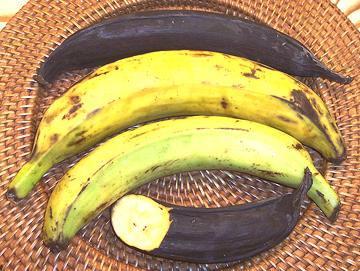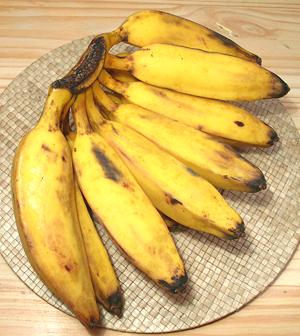The banana plantain is a cash cow. Look at the following for further details.
Bananas are indigenous to Asia. They did well in Africa, America and Caribbean. They taste differently in all these continents. Meet our Banana Connoisseur as we move through crucial steps of identifying bananas to growing them for food or as income generating activity.
Plantain
 [Cooking Banana; Musa acuminata x balbisiana (AAB and ABB groups), formerly Musa paradisiaca]
[Cooking Banana; Musa acuminata x balbisiana (AAB and ABB groups), formerly Musa paradisiaca]
This is the main banana in most of the world. It is starchier than the "desert" bananas like Cavendish and less sweet. Plantains are generally cooked while still green or somewhat green. They are still quite firm when solid yellow and can still be fried in that state. Some recipes call for them ripe, when they will be solid black and finally have softened and sweetened. The flesh tends to be a little orange in color. The average plantain is about 12 inches long and weighs about 9-3/4 ounces.
Plantain Stems [Thor (Bengali)] are eaten particularly in southern India (Tamil Nadu, Assam, Kerala) but also Burma, Thailand and Bali. When the bunch of bananas is harvested, the plant is cut down and layers peeled off to get to the tender central stalk, which looks much like a palm heart. This is chopped and prepared in salads and curries. The outer layers are used for binding string and for weaving mats. These are not available in North America because only certain (mostly wilder) varieties produce edible stems, and they quickly turn ugly brown. Young immature shoots are sometimes cooked and eaten in Ethiopia.
Plantain Roots: Root corms are sometimes eaten in Ethiopia, though not so much as those of the related Enset. They are soft and starchy just before the flowering stage.
Leaves & Blossoms are used the same as banana leaves and blossoms. More on Bananas.
 Philippine Plantain
Philippine Plantain
[Saba Banana, Carababa Banana, Philippine Plantain;Musa acuminata x balbisiana (ABB group)]
These are much smaller than the more common plantains and rather boxy in shape. The photo specimens were between 6 and 6-1/2 inches long (not counting stem) and weighed about 6-1/4 ounces. A 6-1/4 ounce specimen yielded 3 ounces peeled (48%). In the yellow state shown they were rather firm, starchy and not particularly sweet. This plantain is used widely for sweets and savories. Large South American plantains are now grown in the southern Philippines but have not yet caught on yet because their size makes them awkward for the most common use, and because many people are unaware they become sweet enough for their other uses when solid black.
More on Bananas.
bn_plantz 101030 - www.clovegarden.com
©Andrew Grygus - agryg@clovegarden.com - Photos on this page not otherwise credited are © cg1 - Linking to and non-commercial use of this page permitted
Plantain
 [Cooking Banana; Musa acuminata x balbisiana (AAB and ABB groups), formerly Musa paradisiaca]
[Cooking Banana; Musa acuminata x balbisiana (AAB and ABB groups), formerly Musa paradisiaca]This is the main banana in most of the world. It is starchier than the "desert" bananas like Cavendish and less sweet. Plantains are generally cooked while still green or somewhat green. They are still quite firm when solid yellow and can still be fried in that state. Some recipes call for them ripe, when they will be solid black and finally have softened and sweetened. The flesh tends to be a little orange in color. The average plantain is about 12 inches long and weighs about 9-3/4 ounces.
Plantain Stems [Thor (Bengali)] are eaten particularly in southern India (Tamil Nadu, Assam, Kerala) but also Burma, Thailand and Bali. When the bunch of bananas is harvested, the plant is cut down and layers peeled off to get to the tender central stalk, which looks much like a palm heart. This is chopped and prepared in salads and curries. The outer layers are used for binding string and for weaving mats. These are not available in North America because only certain (mostly wilder) varieties produce edible stems, and they quickly turn ugly brown. Young immature shoots are sometimes cooked and eaten in Ethiopia.
Plantain Roots: Root corms are sometimes eaten in Ethiopia, though not so much as those of the related Enset. They are soft and starchy just before the flowering stage.
Leaves & Blossoms are used the same as banana leaves and blossoms. More on Bananas.
 Philippine Plantain
Philippine Plantain[Saba Banana, Carababa Banana, Philippine Plantain;Musa acuminata x balbisiana (ABB group)]
These are much smaller than the more common plantains and rather boxy in shape. The photo specimens were between 6 and 6-1/2 inches long (not counting stem) and weighed about 6-1/4 ounces. A 6-1/4 ounce specimen yielded 3 ounces peeled (48%). In the yellow state shown they were rather firm, starchy and not particularly sweet. This plantain is used widely for sweets and savories. Large South American plantains are now grown in the southern Philippines but have not yet caught on yet because their size makes them awkward for the most common use, and because many people are unaware they become sweet enough for their other uses when solid black.
More on Bananas.
| Plantains are starchier, firmer and less sweet than desert bananas so they are most often cooked rather than eaten raw out of hand. Personally I rather like them just peeled, because I like my fruit snacks a bit less sweet than many do. In southern India the peels are diced small and used in some recipes, but I haven't yet found what kind of recipes. Buying: Plantains are so important to so many tropical cuisines they are available even in some supermarkets in any region that has significant ethnic populations. They ripen fairly slowly, so buy them near the condition you need if you can. They are firm enough to slice and fry from solid green to solid yellow but soften as they turn black. Prep: They peel just like regular bananas. Slice per the recipe you have chosen. Cooking: Because plantains are a staple starch in the tropics worldwide, taking the place potatoes have in more temperate climes, there are many hundreds of ways to cook them. Plantains are most commonly fried in oil until golden brown, then eaten as is or included in recipes. They are often served as a side dish just as potatoes are. They may also be sliced thin and fried crisp like potato chips. |
©Andrew Grygus - agryg@clovegarden.com - Photos on this page not otherwise credited are © cg1 - Linking to and non-commercial use of this page permitted

No comments:
Post a Comment